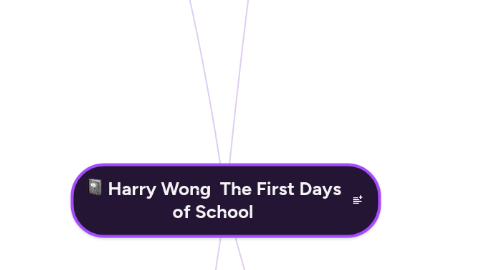
1. David in Blue
2. How to Have an Effective Discipline Plan
2.1. Types of Plans
2.1.1. Teachers in Charge
2.1.1.1. Rules
2.1.1.1.1. General
2.1.1.1.2. Specific
2.1.1.2. Consequences or Choices
2.1.1.2.1. Positive - Rewards
2.1.1.2.2. Negative - Penalties
2.1.1.3. Rewards
2.1.1.4. Characteristics
2.1.1.4.1. Class is teacher-directed
2.1.1.4.2. Teacher is hands-on
2.1.1.4.3. student is offered no choices
2.1.1.4.4. Teacher provides consequences
2.1.1.4.5. Teacher uses intervention and isolation
2.1.1.4.6. Teacher tells what is to be done
2.1.1.4.7. Classroom climate can be tense
2.1.1.4.8. Classroom has limits without freedom
2.1.2. Student and Teacher in Charge
2.1.2.1. Problem-solving
2.1.2.2. Responsibility
2.1.2.3. Self-Discipline
2.1.2.4. Characteristics
2.1.2.4.1. Teacher and student work cooperatively
2.1.2.4.2. Student is offered structured choices
2.1.2.4.3. Teacher asks questions, discusses, and solves problems with students
2.1.2.4.4. Teacher intervenes and agreements reached
2.1.2.4.5. Teacher and student together set limits by establishing a classroom code of conduct
2.1.2.4.6. Classroom has freedom within limits
2.1.3. Students in Charge
2.1.3.1. Raise Responsibility System
2.1.3.1.1. Four Levels of Social Development
2.1.3.1.2. Three Stages of Implementation
2.1.3.2. Characteristics
2.1.3.2.1. Class is student centered
2.1.3.2.2. Teacher is hands-off
2.1.3.2.3. Student has many choices
2.1.3.2.4. Teacher uses nondirective statements
2.1.3.2.5. Student is responsible for conduct
2.1.3.2.6. Teacher listens
2.1.3.2.7. Student is taught responsibility
2.1.3.2.8. Classroom climate can be chaotic
2.1.3.2.9. Classroom has freedom without limits
2.2. Types of Teacher
2.2.1. Reactive - Ineffective, reacts to problems
2.2.2. Proactive - effective, comprehensive plan
3. How to Teach Students to Follow Classroom Procedures
3.1. Planned Procedures for classroom organization
3.1.1. Simplifies the task of succeeding
3.1.2. Discipline vs Procedures
3.1.2.1. Discipline plans have rules - How students behave
3.1.2.2. Procedures are methods for getting things done - How things are done
3.1.2.2.1. Expectations
3.1.2.2.2. Less confusion
3.1.2.2.3. Procedure for everything
3.1.2.2.4. Part of life
3.1.2.2.5. Some Examples of Procedures to Rehearse with Students
3.2. Instructional procedures
3.2.1. Teach - State, explain, model and demonstrate
3.2.2. Rehearse - Practice, Rehearse and practice until it is a habit or routine
3.2.3. Reinforce - Acknowledge the students when the procedure is acceptable
3.3. Systematically teach procedures
4. How Procedures Improve the Opportunity to Learn
4.1. Organized and Predictable
4.1.1. Proper Planning
4.1.2. Consistency
4.1.3. Positive Results
4.2. Procedures Produce Permanent Change
4.2.1. Starting a Class
4.2.1.1. Posted or ready for distribution when students arrive
4.2.1.2. Should be implemented consistently so it becomes routine for students
4.2.2. Movement of Paper
4.2.2.1. Establish a Procedure
4.2.2.1.1. Step 1: Students place their papers on the desk next to theirs.
4.2.2.1.2. Step 2: The next student add his/her paper to the stack and places the stack on the next desk without passing the papers from hand to hand.
4.2.2.1.3. Step 3: Teacher monitor the procedure, makes necessary corrections, and praising when appropriate.
4.2.2.1.4. Step 4: Monitor all rows by walking to the side of the classroom.
4.2.2.1.5. Step 5: Pick up papers or have a student to do so.
4.2.3. Transitioning
4.2.3.1. Establish a Procedure
4.2.3.1.1. Step 1: Close: Give students a time warning to complete current task.
4.2.3.1.2. Step 2: Prepare students for the upcoming task.
4.2.3.1.3. Step 3: Refocus students on the new task at hand.
4.2.4. The Pencil Problem
4.2.4.1. Establish a Procedure
4.2.4.1.1. Step 1: Have two cans at the entrance of the classroom; one labeled "New Pencils" that are sharpened and one labeled "Used Pencils"
4.2.4.1.2. Step 2: As students enter, those who need a pencil will select a sharpened pencil to use for the day.
4.2.4.1.3. Step 3: As students exit, they return the pencil to the "Used Pencil" can.
4.2.5. For Groups
4.2.5.1. Dividing into Groups
4.2.5.1.1. The Class Climate
4.2.5.1.2. The Explanation
4.2.5.2. Structuring Group Activities
4.2.5.2.1. 1. Specify the Group NAME
4.2.5.2.2. 2. Specify the Group SIZE
4.2.5.2.3. 3. State the PURPOSE, MATERIALS, and STEPS
4.2.5.2.4. 4. Teach the PROCEDURES
4.2.5.2.5. 5. Insist on INDIVIDUAL ACCOUNTABILITY
4.2.5.2.6. 6. Teach EVALUATIVE METHODS
4.3. A Plan in Place
4.4. The Class Runs Itself
5. How to Have a Well-Managed Classroom
5.1. I. Classroom management overarches everything in the curriculum
5.1.1. a. The most important factor governing student learning is classroom management
5.1.2. b. The least important factor is the demographics of the student body
5.1.3. c. How you manage the classroom is the primary determinant of how well your students will learn
5.1.4. d. It is the teacher—what the teacher knows and can do—that makes the difference in the classroom
5.2. II. Effective teachers manage their classrooms
5.2.1. a. Effective teachers manage their classrooms, while ineffective teachers discipline their classrooms
5.2.2. b. The most important thing a teacher can provide in the classroom during the first week of school is consistency
5.2.2.1. * Classroom practices and procedures must be predictable and consistent
5.3. III. What is classroom management?
5.3.1. a. Classroom management refers to all of the things a teacher does to organized students, space, time, and materials so student learning can take place
5.3.2. b. A teacher who is grossly inadequate in classroom management skills is probably not going to accomplish much
5.3.3. c. Classroom management skills includes the things a teacher must do toward two ends
5.3.3.1. i. Foster student involvement and cooperation in all classroom activities
5.3.3.2. ii. Establish a productive working environment
5.3.4. d. A well managed classroom has a set of procedures and routines that structure the classroom
5.4. IV. Characteristics of a well-managed classroom
5.4.1. a. Students are deeply involved with their work, especially with academic, teacher-led instruction
5.4.2. b. Students know what is expected of them and are generally successful
5.4.3. c. There is relatively little wasted time, confusion, or disruption
5.4.4. d. The climate of the classroom is work-oriented but relaxed and pleasant
5.5. V. A task oriented and predictable environment
5.5.1. a. A well managed classroom has a task-oriented environment
5.5.2. b. A well managed classroom has a predictable environment
